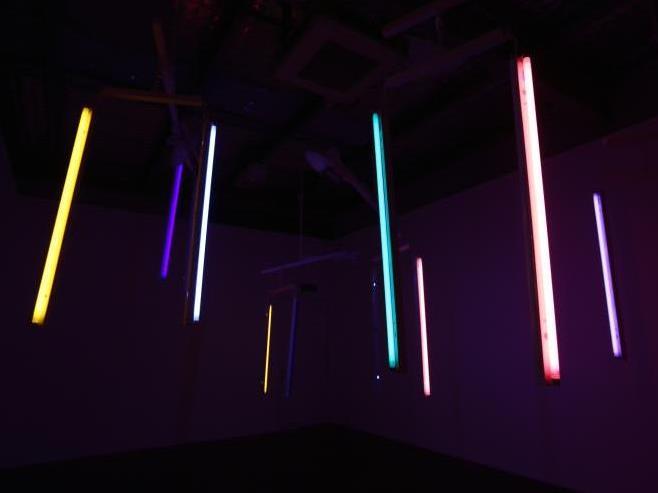Image: www.milanigallery.com.au; by Ross Manning.
Ross Manning, best known for his light installation works, opens the 2016 exhibition program at Milani Gallery with a new body of work. The show extends upon Manning’s fascination with light, sound and movement to deliver a sensory experience exploring the potential for wonder in the everyday.
Working with ordinary objects such as fans, fluorescent lights, microphone stands, motor parts, clock chimes and wires, Manning uncovers relationships that often go unexplored. His practice offers an exploration into the otherworldly by repositioning the mundane. Sound and light installation pieces create startling moments of wonder, reframing how functional objects are viewed.
The strength of the show lies in the success of Manning’s works in revealing hierarchies of aesthetics, consumption and technology. The incorporation of oscillating fans and screens reveals these relationships by placing the everyday into a space of contemplation that is not usually reserved for objects that we encounter as functional. The mood of contemplation and immersion is achieved through thoughtful curating of the exhibition space.
Manning claims a preoccupation with engaging audiences through instinctive response to sensory elements in his works, believing that these elements activate viewers more than traditional mediums. The installation and treatment of the exhibition supports Manning’s philosophy well. In the sizable entrance room, Chronochromie, a large-scale light work is installed. The work is positioned so that the constantly moving structures occupy different sections of the room. The work invades traditional audience space and forces viewers into a state of heightened spatial awareness, experiencing the work from the edges of the room. To move beyond the first room viewers must negotiate the shared space.
Beyond the first room, lights are dimmed as sound installation works are featured. The mood is intimate and allows audiences to focus on the sense being manipulated by the Wave Opus works. The treatment of the rooms is responsive and allows the works to be experienced in line with Manning’s approach to creation and engagement. The installation of the show is clever and responds well to the gallery’s layout, small and large rooms span the two levels, encouraging spatial and sensory interference. What may be a challenging space to work with lends itself well to Manning’s works.
What is most insightful in Manning’s practice, and that this exhibition is successful in teasing out, is Manning’s ability to position an audience to reflect on, and perhaps interrogate, their own interactions with objects in everyday life. Manning opens up the potential to redefine the use and beauty of functional objects by creating a pleasant sensory experience.
The exhibition is enjoyable not only for the immersive experience, but also as it demonstrates Manning’s nuanced approach to inquiry. He successfully prompts reflection on individual and mass reliance on technological elements in everyday life and the simultaneous unobserved use of these ubiquitously encountered objects.
Rating: 3.5 stars out of 5
Ross Manning: New Works
Milani Gallery
Until 27 February 2016





